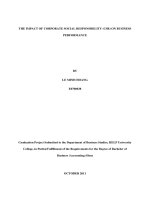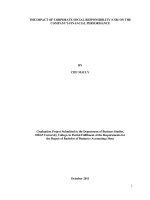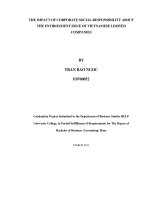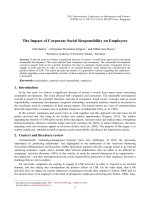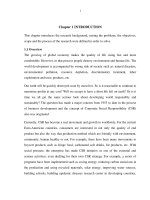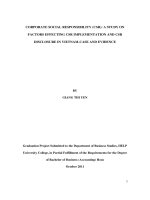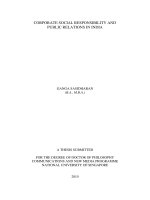Impact of corporate social responsibility and corporate reputation on consumer attitude toward food products and consumer behavioral intention
Bạn đang xem bản rút gọn của tài liệu. Xem và tải ngay bản đầy đủ của tài liệu tại đây (473.42 KB, 97 trang )
UNIVERSITY OF ECONOMICS HO CHI MINH CITY
International School of Business
------------------------------
IMPACT OF CORPORATE SOCIAL
RESPONSIBILITY AND CORPORATE
REPUTATION ON CONSUMER ATTITUDE
TOWARD FOOD PRODUCTS AND CONSUMER
BEHAVIORAL INTENTION
Cao Thị Hải Âu
MASTER OF BUSINESS (Honours)
Ho Chi Minh City – Year 2014
UNIVERSITY OF ECONOMICS HO CHI MINH CITY
International School of Business
------------------------------
IMPACT OF CORPORATE SOCIAL
RESPONSIBILITY AND CORPORATE
REPUTATION ON CONSUMER ATTITUDE
TOWARD FOOD PRODUCTS AND CONSUMER
BEHAVIORAL INTENTION
Cao Thị Hải Âu
ID: 22110003
MASTER OF BUSINESS (Honours)
SUPERVISOR: LƯU TRỌNG TUẤN, PhD.
Ho Chi Minh City – Year 2014
Acknowledgement
I would like express my sincere thankfulness to Dr. LuuTrong Tuan who is my
research supervisor. He helped me to understand the purpose of study research, as well as
the process of research. Thanks to his help, I can understand clearly about the topic I like
and I can complete my thesis. His guidance helps me a lot in performing the thesis,
studying theories, and collecting the data. This thesis could not be finished without his
supporting.
I would like to thank Prof. Nguyen DinhTho and Prof. Nguyen Dong for giving
me helpful advices to correct my thesis. I am grateful to Dr. Nguyen Thi Mai Trang and
Dr. Nguyen ThiNguyetQue with the useful comments for the thesis.
I would like to thank to all staffs of ISB for supporting me during the thesis
processes with informing and guiding accurately and on time.
I would also like to thank to all of my family members, friends who supported and
are by my side throughout my life.
Abstract
Corporate social responsibility is still a new definition to Vietnam, the paper
studies about its influence on consumer attitude and behavioral intention. To investigate
the relationships, the paper needs to search these relationships through corporate
reputation. The data is collected with a sample of 203 customers at super markets with
the method mall-intercept. Those customers are choosing food products and asked permit
to interview. The paper will prove these relationships, the corporate social responsibility
effects on corporate reputation, and corporate reputation effects on consumer attitude,
and consumer attitude influences on consumer behavioral intention. However, the
corporate social responsibility does not effect on consumer attitude. The suggested
hypotheses are proved by data analysis and findings help to the roles of these variables.
Contents
Chapter 1: INTRODUCTION....................................................................................................................... 1
1.1 Introduction: ..................................................................................................................................... 1
1.2 Research Problem: ............................................................................................................................ 2
1.3 Research Objective and Questions: ................................................................................................. 4
1.4 Research Structure: .......................................................................................................................... 4
Chapter 2: LITERATURE REVIEW ............................................................................................................ 6
2.1 Corporate Social Responsibility: ..................................................................................................... 6
2.2 Corporate Reputation: ......................................................................................................................... 8
2.3 Corporate Social Responsibility and Corporate Reputation: ............................................................ 10
2.4 Consumer Attitude toward the Company’s Food Products: ............................................................. 12
2.5 Corporate Social Responsibility and Consumer Attitude toward the Company’s Food Products: ... 15
2.6 Corporate Reputation and Consumer Attitude toward the Company’s Food Products: ................... 18
2.7 Consumer Behavioral Intention: ....................................................................................................... 20
2.8 Consumer Attitude toward the Company’s Food Products and Consumer Behavioral Intention: ... 22
2.9 Model: ............................................................................................................................................... 24
2.10 Summary: ........................................................................................................................................ 26
Chapter 3: METHODOLOGY .................................................................................................................... 27
3.1 Research Approach: .......................................................................................................................... 27
3.2 Survey Research Method: ................................................................................................................. 27
3.3 Questionnaire Design: ....................................................................................................................... 29
3.3.1 Scale Measurement: ................................................................................................................... 31
3.3.2 Questionnaire: ............................................................................................................................ 32
3.4 Sampling Method:............................................................................................................................. 33
3.5 Data Collection: ................................................................................................................................ 33
3.6 Data Preparation: .............................................................................................................................. 34
3.7 Summary: .......................................................................................................................................... 35
Chapter 4: RESULTS AND DISCUSSION ............................................................................................... 36
4.1 Cronbach’s Alpha: ............................................................................................................................ 36
4.2 Exploratory Factor Analysis (EFA): ................................................................................................. 37
4.3 Regression Analysis and Multiple Regression Analysis:.................................................................. 38
4.4 Descriptive Analysis: ........................................................................................................................ 39
4.5 Measurement Assessment: ................................................................................................................ 40
4.5.1 Cronbach’s alpha: ...................................................................................................................... 40
4.5.2 Exploratory factor analysis (EFA): .......................................................................................... 42
4.5.3.1 Testing hypothesis 1: .............................................................................................................. 44
4.5.3.2 Testing hypotheses 2 and hypothesis 3: .................................................................................. 47
4.5.3.3 Testing Hypothesis 4:.............................................................................................................. 50
4.6 Discussion Results: ........................................................................................................................... 53
Chapter 5: CONCLUSION AND IMPLICATION..................................................................................... 56
5.1 Findings: ........................................................................................................................................... 56
5.2 Managerial Implication: .................................................................................................................... 57
5.3 Limitation:......................................................................................................................................... 59
5.4 Future Direction: ............................................................................................................................... 61
REFERENCES ........................................................................................................................................... 62
Chapter 1: INTRODUCTION
1.1 Introduction:
The paper investigates corporate social responsibility (CSR), corporate reputation,
consumer attitude toward the company’s food products, and consumer behavioral
intention; and their relationships. Creyer and Ross (1997) study the relationship between
corporate social responsibility and consumer attitude toward the company’s food
products, they found a positive relationship between them. According to Zaharia (2013),
corporate social responsibility helps companies to build consumer product responses and
product attitudes, corporate social responsibility also effects on product attributes.
Besides, corporate reputation also influences on consumer attitude toward the company’s
food products, as Schwager (2004) defines reputation related to attitude. Sen and
Bhattacharya (2001) say corporate social responsibility is a key component of a firm’s
marketing toolbox to build their corporate reputation; that means a positive relationship
between corporate social responsibility and corporate reputation. The research focuses on
corporate social responsibility and corporate reputation influence on consumer attitude
toward the company’s food products. Attitude changing will lead to behavior changing of
consumer (Eagly&Chaiken, 1993), consumer attitude toward the company’s food
products and consumer behavioral intention has a positive relationship. Both theories of
reasoned action (Fishbein&Ajzen, 1975) and of planned behavior (Ajzen, 1991) consider
behavioral intentions to be the most proximal determinant of behavior, and behavioral
intention is proposed to be influenced attitude that consumer attitude toward the
1
company’s food products towards consumer behavioral intention. By looking and
considering corporate social responsibility and corporate reputation of a company,
consumer can attitude toward their food products; that leads to buy and consume their
food products as consumer behavioral intention. As well as, producers can change their
images by focusing on building their corporate social responsibility and corporate
reputation to lead to consumer attitude toward the company’s food products and gain
customer’s consumer behavioral intention.
1.2 Research Problem:
Vietnam is a communist country that has opened the economics door to integrate
into the global economy by joining ASEAN in 1995, AFTA in 1996; especially Vietnam
has joined WTO since 2007 that opened a new way for Vietnamese economy, as well as
gave many opportunities and challenges to Vietnam companies. Besides the advantages
the economics integrating has given, Vietnam had to face many disadvantages,
difficulties in the process of its development. Vietnam has allowed foreign products that
exported to Vietnamese market. Vietnamese consumers contact with many trademarks of
products, as well as variety quality of products. Vietnamese also has another
consideration about Vietnamese products. One of industrial is food manufacturing is
affected. Vietnamese customers don’t believe in Vietnam food products. They prefer
foreign food products such as milk products for babies; they believe that food products
from famous trade mark have good quality and they trust the guarantee that the famous
organizations posted in the food products’ labels. The Vietnam food production lost their
customer because they lose consumer trust. To attract customers to Vietnam food
2
products, the Vietnam food productions need to build their own strategy to gain customer
trust. The paper supposes to give two supposed factors that maybe influences to attitude
toward food products of costumers in Vietnam market. Additions, the link between
attitude and intention has been explained by Ajzen (1991), and this relationship is also
improved a positive one. The paper studies the indirect impact of supposed variables
corporate social responsibility and corporate reputation on consumer behavioral intention
through consumer attitude toward food products.
Every company has its own aim; that is profit. The profit comes from consuming
products. That their marketing strategy. All of four variables in the paper are areas of
marketing. Because food producers lack of corporate social responsibility and corporate
reputation, customers don’t care their food products and avoid buying their food product.
The paper investigates the relationships of these variables. Food producers can build their
corporate social responsibility and corporate reputation to influence on consumer attitude
toward the company’s food products. From that, customers can buy their food products,
as previous research about the positive relationship between consumer attitude toward the
company’s food products and consumer behavioral intention.
The purpose of building corporate social responsibility is to enhance corporate
reputation, also to gain consumer attitude toward the company’s food products. Food
producers can attract consumer behavioral intention by their corporate social
responsibility and corporate based on the positive relationship of consumer attitude
toward the company’s food products and consumer behavioral intention. Corporate social
responsibility and corporate reputation help food producers to build a long term
3
relationship with the customers based on gaining consumer attitude toward the
company’s food products; the customers would think about their brand when making a
decision on buying food products.
1.3 Research Objective and Questions:
The aim of research is to explore the relationships between supposed factors and
studied variables. Simultaneously, the study shows how the independent variables
influence on the dependent variables. In additions, the data analysis will help to improve
these assumptions.
1. How do the supposed factors influence on consumer behavioral intention?
2. What kind of relationship between independent variables and dependent variables?
3. How strong are these correlations?
To answer the above questions, the author performs step by step to find the final
result. The process is described in research process section. The organized form of the
paper is indicated in the next section.
1.4 Research Structure:
Following the concepts of a typical research paper, the concept of the study is
performed as the list of chapters below:
Chapter 1 illustrates the introduction of the paper, including four sections such as:
introduction, research problem, research questions, research Structure.
4
Chapter 2 presents literature review, which indicates the contents of concepts and the
relationships. The supposed hypotheses and the model of the paper are listed in this
chapter.
Chapter 3 details the process of methodology that describes 8 steps in total. In succession,
these are research process, research problem, research approach, survey research method,
questionnaire design, sampling method, data collection, and data preparation.
Chapter 4 shows the method used to analysis the data and the way of data analysis, as
well as gives the results. This chapter describes how the data is analyzed by using data
single and multiple regression analysis of SPSS 1.6 software.
Chapter 5 summarizes the consequences of the paper, as well as gives
recommends, and supposed the future directions.
5
Chapter 2: LITERATURE REVIEW
The chapter explains the concepts of the paper and describes the relationship
between variables by using the ideas from previous researchers. It shows the previous
studies that mention about the impact of independent variables affecting on dependent
variables.
2.1 Corporate Social Responsibility:
There are diversity definitions to describe corporate social responsibility. One of
them is a concept whereby firms incorporate environmental and social concerns in their
business performances on a voluntary base; this definition is given by the European
Commission that published a Green paper in 2001. According to Brown and Dacin
(1997), an entity’s activities and its social duties and stakeholder obligations describe its
corporate social responsibility. These activities include responsible business practices,
employee volunteering, corporate giving and cause-related marketing; a company which
has social responsible goals, also wishes to bring benefits to its stakeholders that are its
employees, individuals, customers, organization and community (Berger, Cunningham
and Drumwright, 2007).
There are many definitions of corporate social responsibilities. Angelidis and
Ibrahim (1993) define corporate social responsibility is the policy and practice of
corporate social involvement to satisfy social needs. They find the three types of
corporate social responsibilities in their research; these types are sponsorship, causerelated marketing, and philanthropy. These activities show organizational empathy to the
6
community, as well as its stakeholders. Meanwhile in Carroll’s Pyramid Model, he
mentions four different kinds of responsibilities indicating CSR; these are economic,
legal, ethical, and philanthropic (Snider, Hill, & Martin, 2003). Customers carefully
consider a brand, which promises social commitments to their consumers, who would be
influenced about their brand reputation (Pérez, Alcañiz, & Herrera, 2009).
Jamali (2008) says that organizations use corporation social responsibility as a
mean to develop itself, to attract stakeholder’s attention, and contribute to develop social
standards. Meanwhile corporate social responsibility is also defined an engagement of an
entity to enhance higher and higher living conditions while still protecting benefit of the
company, as well as of people both within and outside the firm (Hopkins, 2007).
Corporate social responsibility is also known as the way the organization treat its
stakeholders and community ethically and responsibly. As Carroll (1979) writes, making
good profits is a social responsibility when the company thinks that its business is a part
of social economic system. He also gives four dimensions, such as economic, legal,
ethical, and philanthropic, that described in the model of corporate social responsibility.
Where the economic responsibility involves to getting profits, the company is responsible
to the benefits of stakeholders. The ethical responsibility means about following the laws
of government, relevant international, state, federal, and local. Meanwhile ethical
responsibility talks about moral of an organization; it tries to avoid harm or social injury.
The firm respects moral of community, individuals; as well as does good things even the
laws don’t stipulate these in papers. Finally, philanthropic responsibility shows that the
7
company has the good treating people, loving human policy, many activities and extra
behaviors contributing community, society, and cultural enterprises (Carroll, 1979).
The stakeholders such as the community, customers, employees, employers, etc.
that are in relationship with a firm, can examine these dimensions of corporate social
responsibility of its. Besides, corporate social responsibility is structured by two factors
that are doing good things and avoiding impairments; those describe as a societal
marketing concept, (Petkus and Woodruff, 1992). Concepts as following the laws, not
breaking rules, supporting special cased in society as well as doing charities, protecting
the environment, taking care of employees and people in the community fairly and
ethically, implementing company’s responsibility to the society, etc. also key out the
defining corporate social responsibility.
2.2 Corporate Reputation:
The reputation can be valued as the consequence from doing marketing by
contributing a company’s branding in some fields. It also show to an indication of
behavior and actions in future. Sometimes, it is a possible difficulty for a company to
entry into a field of management; or reputation is a kind of goodwill in accounting. By
producing good product to satisfying experiences from customers builds a reputation of
an organization, (Simon, 1985). Meanwhile Weigelt and Camerer (1988) say the
reputation is a result of many actions in the past that help to assign an image of an entity.
According to Davies, Chun, Silva and Roper (2003); all the organizational actions
from the past perform its reputation; those activities supply to stakeholders about images
8
of the organization, and predict the probable activities and strategy for the marketplace in
the future (Fombrun and Riel, 1997). Smaiziene and Jucevicius (2009) reckon corporate
reputation including all impressions of customers and a company’s stakeholders about the
company by what the company did and does; so corporate reputation is difficult to copy
because it is a unique and intangible asset. Corporate reputation is also what relevant
public knows about a firm, they can judge about an organization through a social
phenomenon that the organization tries to build to its image. Bromley (2001) defines
reputation as a distribution of opinions about a company. According to Herbig and
Milewicz (1993); corporate reputation is the conglomeration or the perceptive assessment
of many groups about the actions of the company. Corporate reputation is viewed as the
external stakeholders’ perception about an organization (Davies & Miles, 1998).
Gotsi and Wilson (2001) state corporate as a reflection of view of consumer in a long
time about a company. Meanwhile, people’s actions toward an organization are
influenced by their beliefs and opinions; that are created into a collective system by the
lasting sensing of a firm holding by an individual, a group or network, says Balmer
(2001). The importance of these factors of corporate reputation is indicated by definition
of reputation, as the below formula (Doorley and Garcia, 2007). Corporate reputation can
be considered as all organizational images that summarize from organizational
performance with organizational behavior plus organizational communication as the
below formula.
Reputation = sum of images = (Performance + Behavior) + Communication.
9
Schwaiger (2004) says that building and corporate reputation sometimes requests
using operationalize images with only connotative attribute. Organization images can
effect on customer central nervous with planned perception; that lead to behavior and
valuation of consumers. The stakeholders, who are impressed by the emotive responses
of community, consumers, investors, staffs, can give estimation about a company based
on its corporate reputation. Fombrun and Shanely (1990) pronounce corporate reputation
as the overall approximation of the organization. Hall (1992) says that corporation
reputation is messages that the company wants to communicate with its stakeholders or
targeted experiences that the company wants to provide to them, and a firm’s reputation
includes emotions and knowledge, what each person has about an organization.
2.3 Corporate Social Responsibility and Corporate Reputation:
According to Fombrun and Shanely (1990), CSR initiatives are means for
organizations to utilize to gain the favorite reputation as its strategy. Companies also use
CSR as a key component of their marketing weapons because it responds to consumer
expectations, improves corporation performance and reputation (Sen and Bhattacharya,
2001). Nan and Heo (2007) also state that CSR initiatives are well established in
marketing literatures as affecting a variety of outcomes; including a firm’s image or
reputation. Polonsky and Speed (2001) also say that the philanthropic type of CSR is
proposed as the most effective initiative to build corporate reputation through association
of causes.
10
In addition, the perceptive intimacy of corporate social responsibility and
corporate reputation is studied and talked about by many papers and researchers. The
potential relationship between corporate social responsibility and corporate reputation is
researched more and more, that helps to increase concepts and studies about it.
Hiilenbrand and Money (2007) state corporate social responsibility and corporate
reputation are mutually arising factors and they are different concepts. The studies firstly
directed to the basal stakeholder group; that are the company’s staffs, employees. This
group communicates to the firm previously because they work for the company. They
judge about the organizational reputation previously by its policy is for its employees.
Fombrun and Shanley (1990) state when a firm builds a good policy, social welfare to
their employees; that means it is building its corporate social responsibility; that will lead
to a good corporate reputation. Such as the better corporate social responsibility the entity
raises, the better reputation the entity gets back. Garberg and Fombrun (20066) also
affirm gaining a good reputation is a result of outcome of corporate social responsibility.
Docherty and Hibbert (2003) say about the relationship between corporate social
responsibility and corporate reputation, there are many studies show strongly that
corporate social responsibility performances are caused surely to corporate reputation
aspiration of an organization. This relationship is considered with a degree of delicacy.
The images and reputation of the firm will be broadcasted to community by articles and
discussions on philanthropy with its corporate social responsibility activities (Porter and
Kramer, 2002). Meanwhile Mutch and Aitken (2009) pronounce that corporate social
11
responsibility plays an important role in making sure of corporate reputation in general.
Corporate social responsibility activities programs highlight their multiple duties in
relation to corporate reputation. The individual companies that promise will play their
role in society as a good entity, would carry out these corporate social responsibility
activities to contribute their reputation. According to Gotsi and Wilson (2001), when the
arms of a company conflict each other, the good way to solve the problem is using
corporate social responsibility as a tool not only to help the firm avoid the troubles, but
only to build and improve its corporate reputation. That means that corporate social
responsibility is also a reputation enhancer. In general, all organizations want to use
corporate social responsibility activities as a weapon to promote its reputation; that is
organizational desirability.
H1: Corporate social responsibility positively influences on corporate reputation.
2.4 Consumer Attitude toward the Company’s Food Products:
Attitude is stated as the level of measurable influence that a person becomes
familiar with using an object (Ajzen and Fishbein, 1972). According to Mathieson
(1991), attitude is drawn as a wish of costumers by performing their goods consumption,
and Ajzen and Fishbein (1972) describe attitude as positive or negative feelings what lead
to target behavior in work setting of workers. Davis, Bagozzi and Warshaw (1989) focus
on a system’s utility, attitude is consider as an enhancer for improving working
productivity if studied with a cognitive perspective.
12
According to Schau, Stevens, Dauphinee and Vecchio (1995), attitude is defined
as a concept including four components, such as affective, cognitive, the value, and the
component of difficulty. Affective is concerned with positive arousing emotions that are
called positive feelings towards statistics. Cognitive includes the processes of perception,
memory, judgment, and reasoning; it shows the capacity of a person of knowledge and
thinking skills in the life; as well as contrasted with emotional and volitional processes.
The value is the worth of something in terms of the useful amount; it shows a perceived
value of something in general life. The component of difficulty is defined that it focuses
on the perception of a subject. Attitude is something that people cannot observe it by their
senses directly; it is counted based on both beliefs as feelings and behavioral
predispositions toward the armed things. Attitude also is defined as estimating bias what
decide the behavioral intention of a person positively or negatively.
Attitude is defined in diversity ways; and the most important definition is about
notion of evaluation. One of definitions about attitude is all of the emotions and feelings
what people experienced and gained when they learn the processing of the studied thing,
(Gal and Ginsburg, 1994). In the paper, attitude can be said as perceptions of consumers
about an organization that can be measured as perceptions based on the affective and
cognitive skulls of knowledge. Petty and Krosnick (1995) based on the notion of
evaluation say that how attitude is viewed depends on the evaluation of objects, such as
beholders, issues, etc. commonly. That follows from positive to negative up to the
dimension ranging. Two angles of this evaluation (base and structure); are the
13
investigating about attitude. These two components of attitude are considered as the label
of attitude strength.
Hoyer and MacInnes (1997) pronounce that attitude is eternal measurement of an
issue, problem, person or action through a process of associating the object. Attitude is
internal evaluation of a person about something such as a company’s product; this causes
the important role of attitude in marketing research. Researching about consumer attitude
shows that one property of attitude is relatively stable and this causes to fixed tendency
that lets to special behavior of costumers (Fishbein and Ajzen, 1975). Because of the
stable angle of attitude, Oskamp (1999) reckons that corporate should build a strategy by
using forecasting about consumer’s behavior toward their products and services. Theories
of Fishbein and Ajzen (1975) about attitude in social psychology literature help others to
continue to study about attitude in research marketing.
Attitude is defined as the judgment level that an individual associates by using an
object (Ajzen&Fishbein, 1972). Besides that, attitude is also identified as a person’s
positive or negative feelings about performing a target behavior in a work setting
(Mathieson, 1991). Mackenzie, Lutz and Belch (1986) define attitude as “a predisposition
to respond in a favorable or unfavorable manner to a particular advertising stimulus
during a particular exposure situation”. Hoyer and MacInnis (1977) say that individual
attitude toward an object also influences on their attitude toward another object that is
related to the first one. That means if costumers favorite a company because of its
corporate social responsibility activities; it will lead to their attitude toward the
14
company’s products or services; or it can be said that corporate social responsibility
activities are transferred as messages making attitude of costumers toward the branded
products and services.
Phelps and hoy (1996) claim that attitude toward something is a tendency in a
positive or negative manner to that thing by perceiving through all its information and
image shown to the individual. Fazio (1995) pronounces that the approachability of
attitudes has important significances for understanding the functioning of attitudes.
Attitudes can sometimes be automatically activated from retention about just
encountering an attitude object. The effectiveness of this consequence grows up as the
accessibility of people’s attitudes toward the attitude object increased (Fazio et al, 1986).
Based on these sayings, consumer attitude toward the company’s food products means
that consumers perceive about the brand food products through information about that
entity.
2.5 Corporate Social Responsibility and Consumer Attitude toward the Company’s
Food Products:
In the time a firm uses its corporate social responsibility initiatives to gain
consumer recognition about the firm’s corporate social responsibility reputation,
Lichtenstein, Drumwright and Braig (2004) have studied that a firm’s corporate social
responsibility reputation influences on consumer responses directly. For instant, the
company perceived corporate benefit and affective attitude (Marin & Ruiz 2007).
15
Corporate social responsibility indicates in several behaviors, activities, or output; the
organizational manager may use it to form the organizational moral risk; these can
influence to the community and public about the company (Kitzmueller and Shimshack,
2012). The directors can use corporate social responsibility as the strategy to affect to
consumer product responses and product attitudes, as well as the beliefs of customers and
product attributes. They also pilot that the corporate social responsibility roll is more and
more important in gaining the consumer perception, may lead to a positive consumer
attitude.
According to Fombrun and Shanely (1990), corporate social responsibility is a
kind of institutional signal used by the public to construct the company’s reputation.
Menon and Kahn (2003) also announce that corporate social responsibility effects on
building corporate reputation of the company. The organizational value system is
transmitted to the customers through corporate social responsibility engagement (Sen and
Bhattacharya, 2001); addition, Menon and Kahn (2003) assume corporate social
responsibility helps to acquire consumers’ positive perception about the organizational
specialties.
Sheik and Rian (2011) claim that the influence of corporate social responsibility;
that considered as the cause; on consumer attitude is controlled by two factors: the
company’s cause fit and customer’s affinity toward the specific cause. The corporate
social responsibility is defined as the cause specificity in the model of Sheik and Rain
(2011). It is also delineated as the level of separateness or understanding of the cause.
16
While the company agrees to support it and stakeholders might demand and pay for it
based on purely monetary incentives. The cause specificity of corporate social
responsibility effects on customer’s attitude toward the company’s products directly or
indirectly. Consumers are willing to favor the organizational products with a positive
cause affinity if they presume that company has a preference of its products strengthens
the cause itself. The cause affinity and cause fit are intermediaries that impulse the direct
impact happened. Meanwhile, the indirect influence of cause affinity helps to promote the
impact of general corporate social responsibility on consumer attitude. Because the
corporate social responsibility information can be tempered by the cause affinity
positively; the cause specificity of corporate social responsibility influences the consumer
attitude toward the company’s products (Sheik and Rian, 2001).
A study of Barlow and Wogalter (1993) claim that the relationships between
companies and their customers exist based on the concept of the social contract.
Individuals focus on the revelation that is highly noticeable about an organization, and
this leads to their attitude toward the firm. When all the organizational information is
broadcasted, they consumers get benefits from this performance. They would notice
about the quality of the organizational products, as well as its side effects by filtering the
important information. Consequently, the customers perceive about the organizational
image; that affects to consumer attitude. The reflection of corporate social responsibility
practices supports the intermediate effect of consumers’ perceived corporate social
17
responsibility practices on their attitudes toward the firm by corporate social
responsibility activities (Barlow and Wogalter, 1993).
According to Torres et al (2007), perceived corporate social responsibility
performances and consumer attitude toward the company’s product can change time by
time. Wang (2009) also examines the relationship between consumer attitude and
corporate social responsibility activities based on the advertising and quality of service
(in another industry). His result gives that consumer attitude toward the company’s
products (or services) of individuals enhance corporate social responsibility
announcement. The relationship between consumer attitude toward the company’s
services or products and perceived corporate social responsibility practices is improved
by Wang’s research along with other relationships
H2: Corporate social responsibility positively influences on consumer attitude
toward the company’s food products
2.6 Corporate Reputation and Consumer Attitude toward the Company’s Food
Products:
About researching impact of corporate reputation on consumer attitude toward the
company’s products, there are various researchers on reputation showing the consumer
attitude is created by corporate members with their company’s reputation. The study of
Schultz et al (2000) shows that the consumer attitude is important to the entire
18
organization, the stakeholders are ready to contribute the main issues of both corporate
reputation and internal communication.
Castaldo et al (2009) assume that companies, which have a reputation for being socially
responsible, will attract consumers to their products while companies with a bad
reputation regarding CSR efforts will be punished by the consumers through, for
instance, boycotts.
Barich and Kotler (1991) assume that attitudes are included in the conceptualization of
the corporate image formation process, and believe that consumer beliefs include
organizational image. That makes attitude and impressions of a person or group about the
company. In their work they consider corporate reputation of favorable public attitude as
a variable, which together with the level of public awareness, determines a firm’s
corporate image. Schwaiger (2004) conceptualizes reputation as related to attitude,
therefore containing affective as well as cognitive components and described solely by
denotative attributes.
To determine how good the corporate reputation from the organizational images,
the customers base on the organizational history, their activities through time, its
historical perspective, etc. By the process, the reputation of the firm is found in
consumers’ mind (Fombrun and Riel, 1997). Bick et al (2003) pilot that; a good corporate
reputation affects to the attitude and behavior of customers. Therefore, attaining the good
corporate reputation ensures the survival situation of the organizations and supports the
growth of the corporate brand in a long term. Meanwhile, Frooman (1999) says that
19

